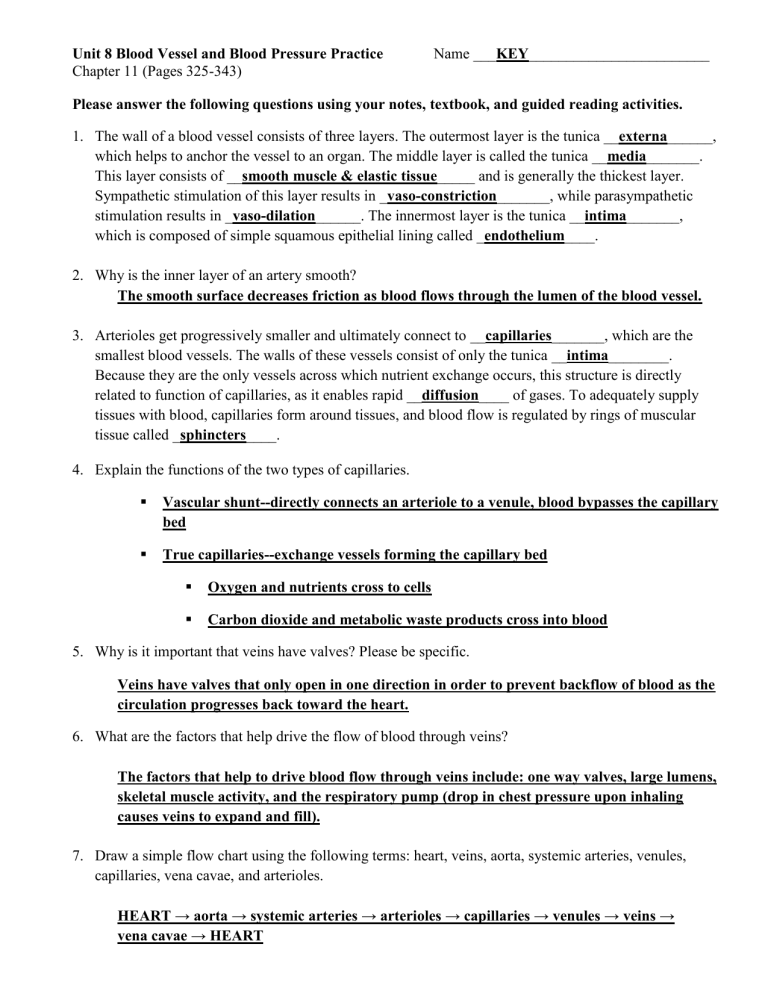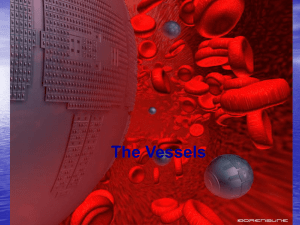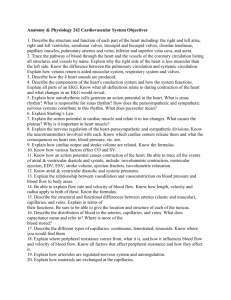Unit 8 Blood Vessel and Blood Pressure Practice KEY

Unit 8 Blood Vessel and Blood Pressure Practice
Chapter 11 (Pages 325-343)
Name ___ KEY ________________________
Please answer the following questions using your notes, textbook, and guided reading activities.
1.
The wall of a blood vessel consists of three layers. The outermost layer is the tunica __ externa ______, which helps to anchor the vessel to an organ. The middle layer is called the tunica __ media _______.
This layer consists of __ smooth muscle & elastic tissue _____ and is generally the thickest layer.
Sympathetic stimulation of this layer results in _ vaso-constriction _______, while parasympathetic stimulation results in _ vaso-dilation ______. The innermost layer is the tunica __ intima _______, which is composed of simple squamous epithelial lining called _ endothelium ____.
2.
Why is the inner layer of an artery smooth?
The smooth surface decreases friction as blood flows through the lumen of the blood vessel.
3.
Arterioles get progressively smaller and ultimately connect to __ capillaries _______, which are the smallest blood vessels. The walls of these vessels consist of only the tunica __ intima ________.
Because they are the only vessels across which nutrient exchange occurs, this structure is directly related to function of capillaries, as it enables rapid __ diffusion ____ of gases. To adequately supply tissues with blood, capillaries form around tissues, and blood flow is regulated by rings of muscular tissue called _ sphincters ____.
4.
Explain the functions of the two types of capillaries.
Vascular shunt--directly connects an arteriole to a venule, blood bypasses the capillary bed
True capillaries--exchange vessels forming the capillary bed
Oxygen and nutrients cross to cells
Carbon dioxide and metabolic waste products cross into blood
5.
Why is it important that veins have valves? Please be specific.
Veins have valves that only open in one direction in order to prevent backflow of blood as the circulation progresses back toward the heart.
6.
What are the factors that help drive the flow of blood through veins?
The factors that help to drive blood flow through veins include: one way valves, large lumens, skeletal muscle activity, and the respiratory pump (drop in chest pressure upon inhaling causes veins to expand and fill).
7.
Draw a simple flow chart using the following terms: heart, veins, aorta, systemic arteries, venules, capillaries, vena cavae, and arterioles.
HEART → aorta → systemic arteries → arterioles → capillaries → venules → veins → vena cavae → HEART
8.
Place in order, numbers 1-6, in front of the statement as they would occur in the human body normally.
_ 2 ___ Used blood travels from the organs to the heart. It is low in oxygen, and therefore, is dark red
_ 6 ___ Blood gets pumped out of the left side of the heart into the body.
_ 5 ___ Blood leaves the lungs through the pulmonary veins back to the heart’s left side
_ 1 ___The body’s organs use oxygen and nutrients from the blood and exchange for wastes.
_ 3 ___ Blood gets pumped out of the right side of the heart.
_ 4 ___ Blood travels through the pulmonary arteries to the lungs where it gets fresh oxygen and becomes bright red.
Blood
Vessel
Systemic
Artery
Capillary
Beds
Systemic
Vein
Carries blood
“towards” or
“away” from heart. away both toward
Pumps
Oxygenated or
Deoxygenated
Blood oxygenated blood loses oxygen as it passes though deoxygenated
Blood under
High or Low
Pressure high low low
9.
_ B & C _ Which of the following is/are true regarding pulse? a.
The faster your heart beats, the slower your pulse will be. b.
Pulse is caused by the expanding and contracting of artery walls. c.
When you count pulse beats, you are also counting heart beats.
Valves or
No Valves no valves no valves valves
Thickness of walls thick very thin thin d.
You can feel pulse in veins, but not in arteries.
Determine what effect the following factors have on blood pressure. Indicate an increase in pressure by using an “
I
” and for a decrease in blood pressure use the letter “
D
.” Place the correct letter response in the space provided.
10.
_ D ___ Increased diameter of the arterioles 20.
_ D ___ Internal bleeding
11.
_ I ___ increased blood viscosity (thickness)
12.
_ I ___ increased cardiac output
13.
_ I ___ increased pulse rate
14.
_ I ___ anxiety; fear
21.
_ D ___ blood donation
22.
_ I ___ a sudden change in position from
reclining to standing
23.
_ I ___ physical exercise
15.
_ D ___ increased urine output
16.
_ D ___ sleeping at night
24.
_ D ___ physical training/conditioning
25.
_ I ___ alcohol usage
17.
_ I ___ eating salty/sugary foods
18.
_ D __ parasympathetic nervous stimulation
26.
_ D ___ hemorrhage (bleeding)
27.
_ I ___ nicotine use (cigarettes, chew, etc.)
19.
_ I ___ sympathetic nervous stimulation
28.
_ I ___ arteriosclerosis (hardening of the
arteries)





